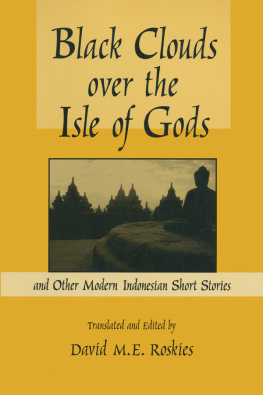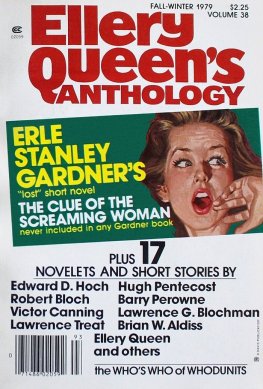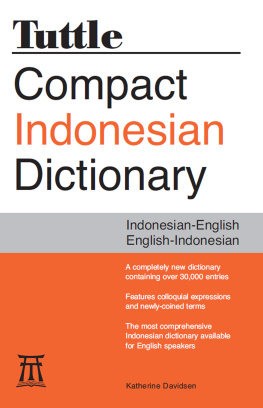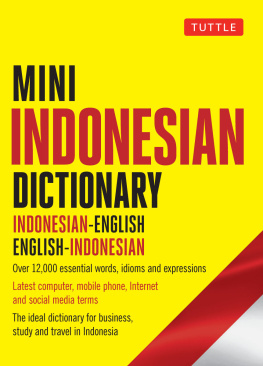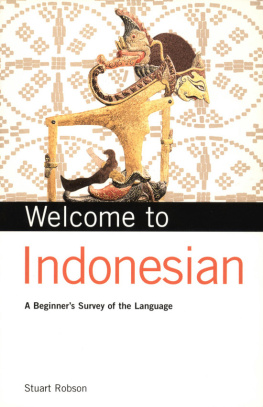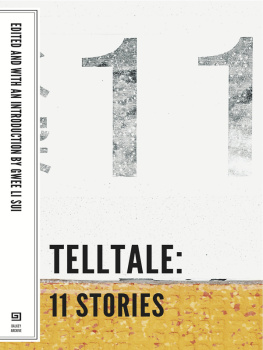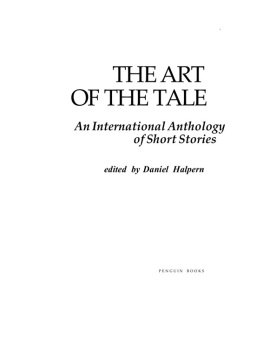Black Clouds over the Isle of Gods
Black Clouds over the Isle of Gods
and Other Modern Indonesian Short Stories
Translated and Edited by
David M.E. Roskies
First published 1997 by M.E. Sharpe
Published 2015 by Routledge
2 Park Square, Milton Park, Abingdon, Oxon OX14 4RN
711 Third Avenue, New York, NY 10017, USA
Routledge is an imprint of the Taylor & Francis Group, an informa business
Copyright 1997 Taylor & Francis. All rights reserved.
No part of this book may be reprinted or reproduced or utilised in any form or by any electronic, mechanical, or other means, now known or hereafter invented, including photocopying and recording, or in any information storage or retrieval system, without permission in writing from the publishers.
Notices
No responsibility is assumed by the publisher for any injury and/or damage to persons or property as a matter of products liability, negligence or otherwise, or from any use of operation of any methods, products, instructions or ideas contained in the material herein.
Practitioners and researchers must always rely on their own experience and knowledge in evaluating and using any information, methods, compounds, or experiments described herein. In using such information or methods they should be mindful of their own safety and the safety of others, including parties for whom they have a professional responsibility.
Product or corporate names may be trademarks or registered trademarks, and are used only for identification and explanation without intent to infringe.
Library of Congress Cataloging-in-Publication Data
Black clouds over the Isle of Gods and other modern Indonesian short stories / translated
and edited by David M. E. Roskies.
p. cm.
ISBN 0-7656-0032-3 (cloth : alk. paper).ISBN 0-7656-0033-1 (pbk. : alk. paper)
1. Short stories, IndonesianTranslations into English.
2. Indonesia fiction20th century.
I. Roskies, David M. E.
PL5088.B57 1997
899.221301802dc21
97-1658
CIP
ISBN 13: 9780765600332 (pbk)
ISBN 13: 9780765600325 (hbk)
Mengenangkan dua sahabat-sahabat terkaribyang tidak terjangkau: E. H. (Kota Kembang Bandung) dan D.D.S. (Kota Suci Al-Quds). Alangkah berliku-likujalan-jalan kehidupan kita, sejak tempo dulu!
Contents
______
Idrus
Pramoedya Ananta Toer
Achdiat Karta Mihardja
A.A. Navis
Nasjah Djamin
Satyagraha Hoerip
S. N. Ratmana
Gerson Poyk
Nh. Dini
Taufiq Ismail
Budi Darma
Putu Wijaya
Asnelly Luthan
F. Rahardi
Danarto
Putu Oka Sukanta
Prasetyohadi
Rahmat Ali
______
Kind thanks are owed to the authors and to the editors for permission to translate; to Pak Julius Sadtono and Mrs. Gloria Poejoesardomo, former colleagues in Singapore, for having answered several queries; and to the publishers copyeditor, Nora Cavin, for intelligent redaction. Rebecca Poston made a number of useful suggestions.
______
Pertemuan, by Nasjah Djamin, Eksentrik, by Asnelly Luthan, Bertarung Dengan Banteng, by F. Rahardi, Garong Garong, by Taufiq Ismail, and Sebelum Yang Terakhir by Satyagraha Hoerip have all been collected in Cerita Pendek Indonesia, a three-volume collection edited by Satyagraha Hoerip (Jakarta: Gramedia Penerbit PT, 1986); the English translations herein have been made with the editors permission. This collection is also the provenance of Anak by Budi Darma and Mendiang by S. N. Ratmana.
Yang Menyewakan Diri first appeared in Pramoedya Ananta Toers Cerita Dari Blora: kumpulan cerita pendek (Jakarta: Balai Pustaka, 1952), and has subsequently been reprinted without change in a volume bearing the same title (Kuala Lumpur: Wira Karya, 1989), from which the present translation has been made. Permission granted by William Morrow and Co. of New York.
Dompet was originally published in Putu Wijayas collection Gres (Jakarta: PN Balai Pustaka, 1982).
Perjalanan first appeared in Nh. Dinis collection Segi dan Garis (Jakarta: PT Dunia Pustaka Jaya, 1983), and has been translated with the authors permission.
Mega Hitam Pula Kayangan first appeared in Putu Oka Sukantas Luh Galuh: kumpulan cerita pendek/kurzgeschichten (Jakarta: Goethe Institut, 1987).
Tukang Potret by Prasetyohadi was first published in Paradoks Kilas Balik: sayembara cerpen Kincir emas, 1988 edited by Ray S. Anitya Dyanoe et al. (Jakarta: Pustaka Sinar Harapan, 1980).
Topihelm first appeared in A. A. Naviss collection Robohnya Surau Kami: eight tjeritapendek pilihan (Bukittinggi and Jakarta: n.v. Nusantara, 1956); permission to reprint with emendation has been given by the editors of the Review of Indonesian and Malayan Affairs, in which a version appeared (25, no. 1, 1992).
Belitan Nasib by Achdiat Karta Mihardja first appeared in Keretakan Dan Ketegangan (Jakarta: Perpustakaan Perguruan Kementerian Pendidikan dan Kebudayaan, 1956), and was translated in Indonesia, the journal of Cornell Universitys Modern Indonesia Project (no. 30, April 1991). Permission to reproduce with revisions has been granted by the editors.
Heiho, Sanyo, and Jawa Baru by Idrus first appeared in Idruss collection Dari Ave Maria Ke Jalan Lain ke Roma (Jakarta: Balai Pustaka, 1948); the translations slightly adapt versions first prepared for Yayasan Lontar in Jakarta and are published with its permission.
Kena Jaring by Rahmat Ali first appeared in Sayembara Kincir Emas (Jakarta: Sinar Harapan/Radio Nederlands Weldenroep, 1975).
______
T his little book is neither a survey nor a scholarly study. It serves a different and altogether more modest purpose: to offer the general reader and the Indonesia enthusiast a range of stories from a vast, complex, and intoxicatingly interesting country. It goes without saying that the subjects, character, and merit of the selections vary. But in its own way each communicates something of Indonesias distinctive and manifold life; and each, in its own way, is entertaining.
Generally speaking, the short story is the least forgiving of forms. Ideally it should echo, should expand across its economy; in short, it should be enormous. Novels, Henry Jamess loose, baggy monsters, are easily forgotten. Stories, irrespective of their provenance, stay in the mind; a really good story creates its own self and subject, in a way peculiar to itself. In Indonesia particularly, the short story enjoys the further advantage of being by far the favored prose form. It is not difficult to understand why this should be so. A novel-consuming public lives in cities and has leisure time to fill, cash to spare, a modicum of privacyand electric light to read by. Impoverished, for the most part; deprived of educational opportunities until very late in the Dutch colonial period; living in dense agglomerations in rural surroundings, the majority of people in what used to be known as the Netherlands East Indies were illiterate. Those who werent were disinclined to buy bound volumes, and still less to read them for pleasure; in any case, apart from the fact that their traditional culture was largely visual and oral, they hadnt the means. Relative to absolute numbers, the reading and book-buying public in the colonial Indies was minuscule. Publishing on an industrial scale and in the sense taken for granted in Atlantic societies was in its infancy and catered to the needs of small European and Eurasian minorities.

